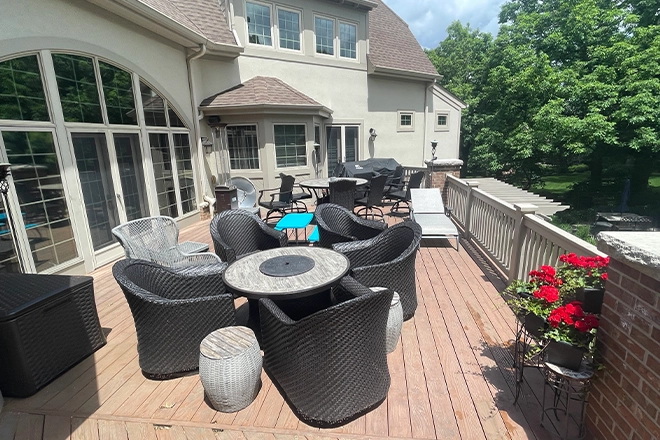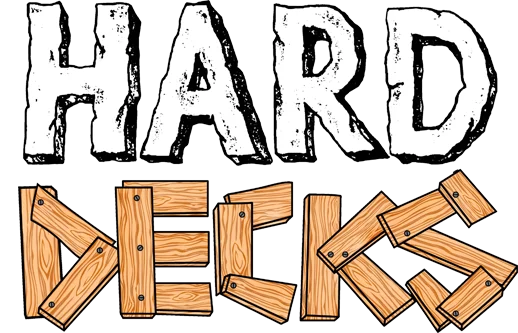
Style Your Backyard With the Right Deck Style
Wish your backyard had more personality than a plain patch of grass? Are you curious about what kind of deck would actually work best with your house and your lifestyle?
This post will break down all the main types of decks—from the most popular to lesser-known types you might not have considered.
By the end, you’ll know exactly which deck type fits your deck installation vision.
What Are the Different Types of Decks?
There are several types of decks to choose from, each with unique benefits depending on your home’s architecture, yard layout, and how you plan to use the space.
Here’s a quick list of the most common deck types:
- Attached Deck
- Detached or Floating Deck
- Wraparound Deck
- Multi-Level Deck
- Second-Story Deck
- Double Decker Deck
- Rooftop Deck
- Curved Deck
- L-Shaped Wraparound Deck
- Rectangle with Octagon Deck
- Deck with Angled Corners
- Low Square Deck
- High-Rise Rectangle Deck
- Pool Deck
Contact us today about your deck installation.
1. Attached Deck
An attached deck connects directly to the house, usually of a kitchen or dining room, and blends indoor and outdoor living spaces.
This deck layout is one of the most popular deck types because it’s easy to access, highly versatile, and adds real function to the home.
Attached decks often feel like an extension of your floor plan, especially when built at the same level as your home’s interior. They’re ideal for hosting friends, firing up the grill, or just enjoying your morning coffee a few steps from the couch.
If you’re planning a deck project, this option works great with common deck materials like composite decking, pressure-treated wood, or natural wood boards such as cedar or redwood.
Just keep in mind you’ll need to meet building code requirements where the deck connects to the house.
2. Detached Deck
A detached deck, also called a freestanding or floating deck, stands alone somewhere in your yard instead of being directly connected to your house.
This setup gives you a lot more flexibility in terms of location, design, and elevation.
It’s a great choice for homes with rocky landscaping or sloped yards or if you just want to create a cozy retreat in a quiet corner of your outdoor space. Detached decks also avoid some structural requirements since they don’t rely on the house for support.
They can be built with a wide range of deck materials. Pressure-treated lumber and composite decking are good choices that stand up to the elements.
While they often require a few extra steps for leveling and support, the result is a flexible and usable outdoor space.
3. Wraparound Deck
A wraparound deck literally wraps around one or more sides of your home, offering several access points and tons of usable outdoor space.
These decks are especially popular on larger properties or homes with a view on more than one side.
The layout is perfect if you want to move between sun and shade throughout the day. It also increases the amount of living space outside without interfering with the interior floor plan.
Wraparound decks typically cover a large area. Choosing a durable, low-maintenance material like composite decking or PVC decking can help reduce the maintenance required in the long term.
With the right planning, a wraparound deck can become the most dynamic outdoor living space you have.
4. Multi-Level Deck
Multi-level decks feature more than one level of platforms, often connected by stairs, to create zones throughout your outdoor space.
These deck styles are ideal for sloped yards or homes with walkout basements.
Each level can serve a different purpose—grilling on one, dining on another, and lounging on a third. It’s a smart way to organize your living space without cluttering a single flat deck.
Multi-level decks require thoughtful planning to meet code requirements and structural stability, but they offer unmatched design flexibility. You’ll often see composite or wood decking used to define each level and add visual appeal.
Deck design ideas and tips you’ll love.
5. Second-Story Deck
A second-story deck is built off the upper level of a home, often accessed from a bedroom or living room.
These elevated decks are perfect for enjoying a unique view or creating shade over a patio or ground-level space below.
Because second-story decks are high off the ground, they require strong support posts and railings to meet safety standards. But with the right design, they can double your outdoor living space without taking up any yard at all.
These decks are usually made from low-maintenance materials like composite or PVC decking to cut down on upkeep in a more exposed location.
If you’re working with a hilly lot or two-story home, this style makes the most of your vertical square footage.
6. Double-Decker Deck
A double-decker deck is a dramatic setup with two stacked levels of usable space.
It’s a great fit for large homes or hillside lots where you want multiple outdoor zones but don’t want to eat into your yard.
The upper deck often includes railings and seating with a view. The lower deck is great for shade or more private gatherings.
Together, they offer twice the functionality without expanding the footprint.
Double decks can be more expensive and require expert planning, especially when combining different deck materials or load-bearing elements.
Still, for homeowners looking to maximize outdoor living, this deck type delivers on every level.
7. Rooftop Deck
Rooftop decks are built on top of flat-roofed homes or buildings.
If you don’t have a backyard, this is a creative way to create a private, elevated outdoor space.
Rooftop deck ideas often include planters, lighting, and furniture to create an outdoor lounge high above the street.
Keep in mind that rooftop decks require extra structural support and waterproofing. They may have to meet stricter building code requirements.
Because they’re exposed to a lot of sun and elements, materials like composite decking or fade-resistant PVC are commonly used.
Rooftop decks turn unused overhead space into the ultimate retreat.
8. Curved Deck
Curved decks ditch the boxy look in favor of sweeping lines and organic shapes.
They bring a soft, modern feel to any yard and are often designed to follow natural contours in the landscape.
This style is commonly built using composite decking, which bends with heat and is easier to mold into curves than wood. The result is a smooth, visually interesting outdoor space that stands out from traditional layouts.
Curved decks are usually custom builds, so they come with a higher cost and longer timeline—but the visual appeal is hard to beat.
9. L-Shaped Wraparound Deck
L-shaped decks wrap around two sides of a home, usually meeting at a corner.
They give you plenty of space to spread out and create zones for cooking, dining, or relaxing.
This layout works well with ranch-style homes or properties where one continuous deck would block light or access. Like a traditional wraparound deck, it provides excellent flow between indoor and outdoor spaces.
Because L-shaped decks tend to be large, durable, low-maintenance deck materials like PVC decking or composite are often preferred.
10. Rectangle with Octagon Deck
This design combines a simple rectangular base with an added octagon bump-out, usually for a seating area or fire pit.
It adds depth and dimension to your deck while still keeping the overall layout simple.
The octagonal section creates a natural focal point for gatherings. The shape blends well with patios and backyard landscaping.
It’s an easy way to add visual interest without a full custom build.
11. Deck with Angled Corners
Rather than using 90-degree corners, angled corner decks add a slight diagonal to one or more edges.
This small shift creates a more polished look and can help your deck better align with the shape of your home or yard.
Angled corners can also improve flow, making it easier to walk around railings or furniture. While they require a bit more cutting and planning, the results are often more stylish and space-efficient.
12. Low Square Deck
Low square decks are simple, ground-level platforms with clean lines and no elevation.
They’re perfect for small yards, modest budgets, or homes that don’t require stairs.
Because they sit right on or near the ground, these decks usually don’t need railings and are faster to install. They’re often built from pressure-treated lumber or composite for easy upkeep.
13. High-Rise Rectangle Deck
A high-rise rectangle deck is an elevated, no-frills design that delivers plenty of space and a strong visual structure.
These decks are especially popular for second-story homes or vacation properties with views.
They may look simple, but their height means structural supports, railings, and building codes all need close attention. The clean lines work well with most home styles and create a bold outdoor statement.
14. Pool Deck
A pool deck surrounds or connects to a swimming pool.
They create a safe, slip-resistant surface to walk, lounge, and relax. The materials need to handle constant moisture, strong sun, and heavy foot traffic.
Popular choices include composite decking and PVC decking for their water resistance and minimal maintenance. Depending on the design, you can create an elegant poolside experience that rivals any resort.
Deck Types by Material
Choosing the right deck materials is just as important as choosing the style. Each material has different pros, cons, costs, and maintenance requirements.
Natural Wood
Wood decking like cedar, redwood, and tropical hardwoods offers timeless beauty and a natural feel. They require sealing, staining, and regular cleaning to prevent insect damage, rot, and sun fading.
Pressure-Treated Lumber
Pressure-treated wood is one of the most affordable and widely used options. It’s chemically treated to resist bugs and decay but will need maintenance to prevent warping and splintering over time.
Composite Decking
Made from wood fibers and recycled plastics, composite decking is durable, fade-resistant, and needs very little upkeep. It’s ideal for homeowners who want less maintenance without sacrificing appearance.
PVC Decking
Also known as polyvinyl chloride decking, PVC boards are completely synthetic and virtually waterproof. They’re great in humid, wet areas or around pools where moisture is constant.
Concrete or Stone
These are often used for ground-level patio-style decks. While heavy and limited in design, they’re very durable and don’t require much upkeep once installed.
Aluminum
Aluminum decking is tough, rustproof, and long-lasting. It’s a smart pick for commercial decks or extreme climates, though its industrial look isn’t for everyone.
Help Your Backyard Find Its Footing with Hard Decks
Whether you’re dreaming of a simple platform or planning a multi-level backyard masterpiece, Hard Decks has the skills and experience to bring your outdoor space to life in Illinois. We install all deck styles using top-quality deck materials built to last through every season.
If you’re ready to add more usable outdoor space to your home, we’re here to help. Just fill out our contact form today or give us a call.
